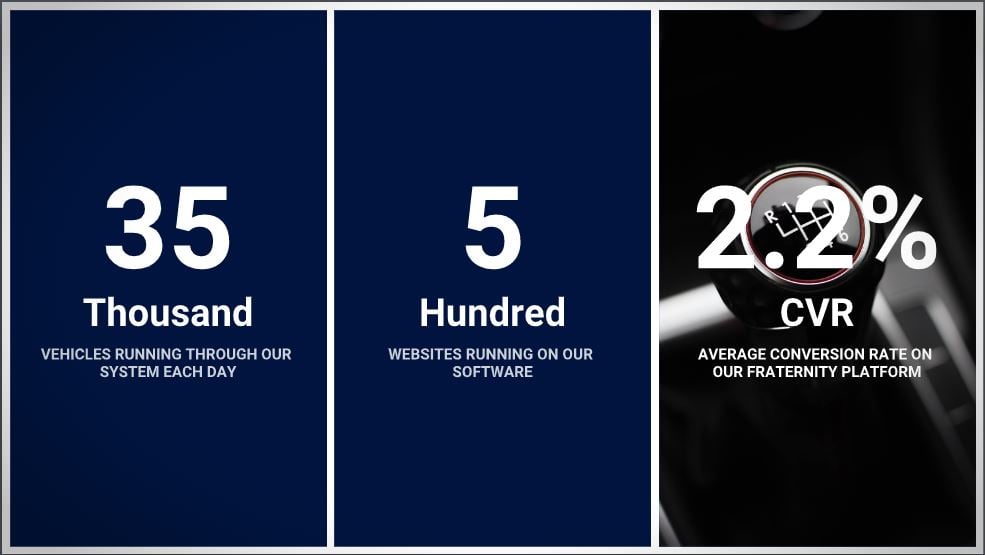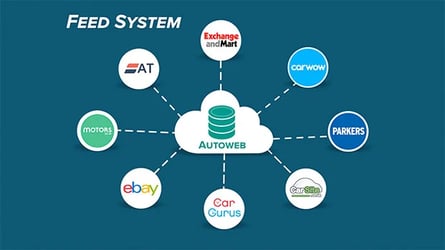Dealer Stock Feed System - Ad Manager
The Enterprise-Ready Vehicle Stock Feed Management System for Dealerships
Autoweb's Ad Manager software provides dealers with advert efficiency and accuracy so they know that stock is advertised in the right way, at the right time and in the right places. With outbound feeds to industry names like Auto Trader, Motors, CarGurus, AA Cars, eBay, Facebook and Google, dealers can manage their vehicle adverts across websites and sales channels in a scalable way.
In the fast-paced world of automotive retail, efficiency, flexibility and accuracy are essential. Having been an automotive retail provider for twenty years, we understand and appreciate this more than most and through continual innovation our stock feed system stands above the competition.

Proven Reliability at Scale
Some solutions may offer a level of flexibility, but too often, these implementations are done in ways that are not scalable or maintainable. Our core software manages thousands of dealer feeds daily, which is critical in offering proven reliability so that dealership ads are not only feature-rich and attractive but are shown on the right advertising platforms correctly and accurately.
Providing the flexibility that dealerships need
Vehicle data within a dealership often contains errors, such as needing to be completed or formatted correctly; this is the reality of working with manually entered data. Many feed management systems require input in a very rigid format, a popular format being DMS14 feed files.
For many dealerships, setting up a feed from their DMS to a feed management solution in an error-free DMS format isn't really possible. Autoweb's feed management software has a sophisticated translation layer that can turn a dealer's data into advert data seamlessly and at scale. The same process can be applied to outbound feeds, meaning compatibility covering the whole market.
In addition to working with data structured in different ways, our software is highly flexible when working with different file formats. For scheduled feeds that do not run via API, CSV format is widely used for stock feed integration, but it is not always the ideal type of file for a dealership to use. We can work with dealerships to advise on the simplest way to achieve stock feed integration by using APIs or structured files such as an XML file, CSV file or a different file format.

Functionality
As an established, enterprise-scale solution, Autoweb's stock feed management platform has reporting and functionality built up over two decades of dealer input, and this development is continuous, so the latest technology is there when you need it. In addition to in-house development, Autoweb's approach to partnerships and integrations means that the latest innovations within vehicle advertising are offered within the system. A demonstration is always best for the latest information - this can be done quickly online.
The Right Service and Support
Autoweb's vision statement includes providing the best customer service in the industry. When you go into our offices, this is clear, with many team members focused on different levels of technical support.
Our first aim is to reduce the likelihood of feed errors. Our expert data management advisors can help you set up your vehicle feeds in a robust, easy-to-understand way that still provides the flexibility you need. We have many clients who have used alternative feed solutions and have remarked on the transparent account management process that has led to improvements in their setup that they can understand in non-technical terms. The key to doing this is our powerful and flexible feed platform.
Even with a reliable system, dealers know that stock feeds can fail to be accepted by an advertiser for all sorts of reasons stemming from the ever-changing automotive market and OEM data. When vehicle advert feeds are not accepted by an advertiser for whatever reason, it is usually business critical, so a fast response and fix is what a dealership needs. This need for urgency is at the core of Autoweb's values and can be seen in the attitudes of our team members. Please get in touch if you would like to know more about our SLAs and procedures for emergency and out-of-hours support.

Inbound Feeds
Integrations with all popular DMS (Dealer Management System) providers, dealer website providers, manufacturer UVLs and advertising portals. Inbound feeds from Auto Trader can use the real-time Auto Trader Connect API as well as other Auto Trader Platforms for vehicle feeds.
Outbound Feeds
New integrations are added continuously as new innovations hit the automotive retail market. All of the big names are covered, and many smaller ones - If a dealer has a specific request, then this can also prompt new feed creation.


New and Used Cars or Vans
Whether a vehicle is a car or a van and whether it is physically in stock, registered or unregistered does not matter to our software. We offer an unrivalled level of customisation for your stock feeds in whatever form. A typical use case for this approach is when showing a consumer new and used vehicle adverts in the same list.
Data Expertise
Autoweb has greatly supported data-driven decision-making for years. Our experts can guide you on how to link stock vehicle data within systems such as Google Analytics, the Google Tag Manager data layer and your CRM or DMS to create reports and insights that can give you a competitive advantage through informed decision-making.

Additional System Benefits
Efficiency and Time Savings
Managing vehicle stock manually can be time-consuming and prone to errors. Autoweb's software automates many tasks, such as updating vehicle listings and distributing them to multiple platforms. This efficiency allows dealership staff to focus on more strategic and customer-facing activities.
Consistency Across Channels
Inconsistent or outdated stock information across different platforms can confuse potential buyers and erode trust. Autoweb's software ensures that vehicle listings are uniform and accurate across the dealership's website, third-party websites, and social media, presenting a professional and reliable image to customers.
Improved Customer Experience
With more time to spend on quality images, videos and information, dealers can provide potential buyers with a better vehicle search experience. Consumers can browse a dealership's stock and vehicle offers conveniently with access to comprehensive vehicle details.
Streamlined Marketing
Enhancing vehicle adverts with eye-catching or interactive elements is a fundamental need within automotive marketing that our software leads the field with. Enhancements can include high-resolution images, detailed vehicle descriptions, and easy access to vehicle financing options. All of these elements contribute to more effective marketing and increased sales.
Data-Driven Decisions
Analytics and reporting within the software empower dealerships to make data-driven decisions. By analysing stock performance, dealerships can adjust their strategies, pricing, and marketing efforts for better results.
What is a Vehicle Feed Management System?
Automotive retailers use a vehicle feed management system (or stock feed system) to streamline and automate the management of their vehicles in stock.
Typically, vehicles are entered either manually via a user interface or through inbound stock feeds from a dealer management system (DMS) or another source, which is often via an API, CSV file feed through FTP or another type of scheduled feed such as those using XML files.
Once the system receives a vehicle's information, its data is usually enriched and/or transformed to make it compatible with the system's data structure. From here, the data can be automatically enhanced with information from other sources. For example, many dealerships add vehicle specification data from Auto Trader or CAP to their vehicle information through integrations.
With a vehicle's data within the feed management system, dealers can typically log in and amend or add to this information with media such as photos or videos and additional descriptions, as well as manage the vehicle's pricing before or during live advertising. Once this process is finished, the vehicle can be published as an advert.
When an advert is ready, the stock feed management system will typically send the advert information to third-party advertisers (e.g. Auto Trader) and the dealer's website either through API integration or via a scheduled stock feed file.
Within the system, dealers can typically run reports on their vehicles in stock, such as the number of images per vehicle, days in stock and stock mix.
The typical alternative to using a stock feed system is a combination of spreadsheets and manual data entry into the systems that advertise vehicles. The significant drawback of this approach for consumers is that they must wait for data to be entered into the platform they are looking at before seeing stock updates. The drawbacks for a dealerships is are quite major as well. The dealer has to repeat the manual task of entering vehicle information and images several times in addition to making multiple edits if something changes, such as the price of a car or van. This repetition is required for all everyday tasks like adding additional images or providing a special price or promotion.

Choosing the Right Vehicle Stock Feed Management System
Whether you are a car dealer, van dealer or OEM, we think that you will be blown away by our capabilities and approach to managing dealer feeds, but choosing a software partner is a significant decision so we have provided some things to consider when selecting a vehicle stock feed management system for your dealership below.
Things to Consider
Compatibility: Ensure the system integrates seamlessly with your existing dealership management software (DMS), website platform, and third-party marketplaces. Also, consider compatibility with providers of video/imagery, finance and vehicle specification information.
Scalability: Choose a system that can grow with your dealership as your stock, location and needs expand both in terms of the amount of data and the complexity of how it is used.
Reliability: Choose a reliable system. Such a system is likely to be a more mature, established system with a track record of servicing large numbers of dealerships.
User-Friendliness: The system should be easy for your staff to learn and use, reducing the learning curve and increasing productivity.
Customisation: Look for a system that allows you to tailor vehicle listings to match your dealership's branding and marketing strategies. Also, consider requirements for your vehicle data such as advert currency, drive-away price, dealer delivery, reserved vehicles or marketing promotions.
Support and Training: Consider the customer support and training level provided by the system's vendor.
Security: Ensure that the system adheres to the information security practices that you need.
Cost: Evaluate the pricing model and total cost of ownership, including any subscription fees or future customisation costs.
Roadmap: How has the system adapted to recent changes in the industry, and what is the vendor's future development roadmap?
